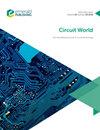HMSIW- and QMSIW-based antenna for wireless communication application
IF 0.7
4区 工程技术
Q4 ENGINEERING, ELECTRICAL & ELECTRONIC
引用次数: 0
Abstract
Purpose The purpose of this paper is to design and develop half-mode substrate-integrated waveguide (HMSIW)- and quarter-mode substrate-integrated waveguide (QMSIW)-based antennas for wireless communication application. The developed antennas offer advantages in terms of compactness, high gain and better isolation between the ports. Design/methodology/approach Initially, the tri-band substrate-integrated waveguide-based antenna is designed using a slot on the ground plane. Then, the same structure has been bisected into two parts for the development of the HMSIW structure. Again the concept of the slot is used for the realization of a dual-band antenna. QMSIW-based structure is designed with further dividing HMSIW structure into two parts. Simulation has been carried out with the use of a high-frequency structure simulator (HFSS) software, which used a finite element-based solver for the full-wave analysis. Findings The proposed HMSIW-based dual-band antenna resonates at two different frequencies, namely, 5.81 GHz with 4.5 dBi gain and at 6.19 GHz with 6.8 dBi gain. Isolation between two ports is 20 dB. The overall dimensions of the proposed model are 0.39 λ × 0.39 λ. Similarly, QMSIW-based antenna is resonated at 5.66 GHz of the frequency with the 3 dBi gain. Frequency tuning is also carried out with the change in the slot dimension to use the proposed antenna in various C (4–8 GHz) band applications. Originality/value The proposed antennas can use C band wireless frequency application. The proposed structure provides better performance in terms of isolation between the ports, small size, high front-to-back ratio and higher gain. It is fabricated for the proof of concept with the RT Duroid 5880 substrate material having a 2.2 permittivity. Measured results show a similar kind of performance as a simulated one.用于无线通信应用的基于HMSIW和QMSIW的天线
目的设计和研制基于半模基片集成波导(HMSIW)和四分之一模基片集成波导(QMSIW)的无线通信天线。开发的天线在紧凑,高增益和端口之间更好的隔离方面具有优势。设计/方法/方法最初,基于基片集成波导的三波段天线是利用地平面上的插槽设计的。然后,将同一结构分成两部分进行HMSIW结构的开发。狭槽的概念再次用于实现双频天线。设计了基于qmsiw的结构,并将其进一步分为两部分。利用高频结构模拟器(HFSS)软件进行了仿真,该软件采用基于有限元的求解器进行全波分析。研究结果基于hmsiw的双频天线在5.81 GHz和6.19 GHz两个不同的频率下谐振,分别为4.5 dBi增益和6.8 dBi增益。两个端口之间的隔离度为20db。模型的整体尺寸为0.39 λ × 0.39 λ。同样,基于qmsiw的天线谐振频率为5.66 GHz,增益为3dbi。频率调谐也随着插槽尺寸的变化而进行,以便在各种C (4-8 GHz)频段应用中使用所建议的天线。提出的天线可以使用C波段无线频率应用。所提出的结构在端口之间的隔离、小尺寸、高前后比和更高增益方面具有更好的性能。它是为具有2.2介电常数的RT durid 5880衬底材料的概念验证而制造的。测量结果显示出与模拟结果相似的性能。
本文章由计算机程序翻译,如有差异,请以英文原文为准。
求助全文
约1分钟内获得全文
求助全文
来源期刊

Circuit World
工程技术-材料科学:综合
CiteScore
2.60
自引率
0.00%
发文量
33
审稿时长
>12 weeks
期刊介绍:
Circuit World is a platform for state of the art, technical papers and editorials in the areas of electronics circuit, component, assembly, and product design, manufacture, test, and use, including quality, reliability and safety. The journal comprises the multidisciplinary study of the various theories, methodologies, technologies, processes and applications relating to todays and future electronics. Circuit World provides a comprehensive and authoritative information source for research, application and current awareness purposes.
Circuit World covers a broad range of topics, including:
• Circuit theory, design methodology, analysis and simulation
• Digital, analog, microwave and optoelectronic integrated circuits
• Semiconductors, passives, connectors and sensors
• Electronic packaging of components, assemblies and products
• PCB design technologies and processes (controlled impedance, high-speed PCBs, laminates and lamination, laser processes and drilling, moulded interconnect devices, multilayer boards, optical PCBs, single- and double-sided boards, soldering and solderable finishes)
• Design for X (including manufacturability, quality, reliability, maintainability, sustainment, safety, reuse, disposal)
• Internet of Things (IoT).
 求助内容:
求助内容: 应助结果提醒方式:
应助结果提醒方式:


